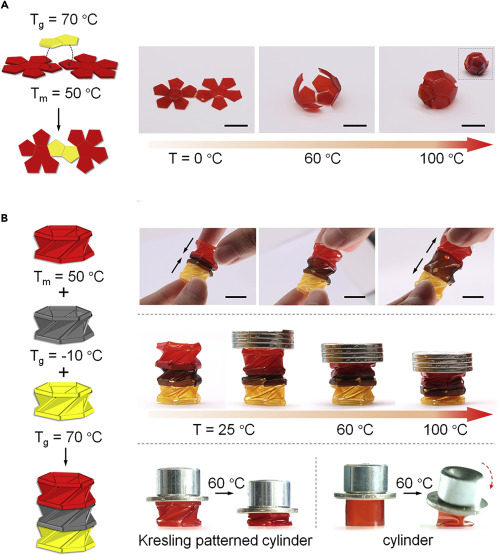Researchers from the College of Chemical and Biological Engineering at Zhejiang University have been exploring an even more complex realm of digital fabrication, releasing their findings in ‘Modular 4D Printing via Interfacial Welding of Digital Light-Controllable Dynamic Covalent Polymer Networks.’
Historically, 3D printing has offered a wide range of benefits to users on many levels; however, users are still often restricted and challenged due to issues like slower speed or lack of suitable materials. 4D printing may be faster, but the authors note that more complex geometries may not be accessible, and the potential for using multiple materials may be restricted.
In this study, the authors steer away from the typical mode of layered fabrication, using a modular system developed through interfacial welding of digital light-controllable structures that can be customized, 3D printed, and assembled in a modular network:
“This expansion is non-trivial as it opens up ways to fabricate geometrically complex devices with sophisticated functions that are otherwise difficult with existing approaches. We note that recent work has shown multi-materials integration in 4D printing via direct ink writing. Although the method involves stresses from bilayers, at the global level the shape shifting is still limited to single-layer 2D-to-3D transformation.”
Double-sided digital light is projected onto a ‘printing precursor’ made of monomers that are not only photocurable but also encompass the following:
- Dynamic covalent bonds
- Photo-initiator
- Light absorber
- Solvent (toluene)
Exposure of the light results in curing, along with ‘enhancing the light attenuation,’ and consequently creating a curing gradient that exists in the out-of-plane gradient.
“Subsequent removal of the uncured monomers and solvent from the cured film develops the 2D film into 3D due to the material heterogeneity in the out-of-plane dimension,” state the researchers. “Following this process, independent variations in the printing precursors can result in 3D objects with tailorable materials properties, which we call 3D material modules.”
The modules feature shapes that are separately manipulated and connected through interfacial welding via dynamic covalent bond exchange. The authors used a set of monomers/crosslinker to offer a better understanding of this principle. Variations caused different types of material modules, as follows:
- PPIA20-IBOA80
- PPIA50-PEA50
- PPIA20-PEA80
The 4D modular structure not only expands beyond 3D printing but is more robust and offers versatility, as displayed in the two samples printed—one of PPIA20-IBOA80 and one of PPIA50-PEA50. Both were connected by applying pressure to the hinged area while welding. The 4D qualities, deformation and then returning to the initial state, were displayed due to temperature as they were reheated.
“An important feature during the process is that the deformation is dictated by the Kresling pattern, yielding a pattern-directed controlled rotation that improves the mechanical stability of the device,” concluded the researchers.
“Besides having the advantages of current 4D printing technologies, the exchangeable nature of the dynamic bonds in the printed polymer networks brings several rather notable benefits. The solid-state plasticity via bond exchange in the material bulk permits further manipulation of the printed shapes. The interfacial bond exchange between material modules formulated separately allows the integration of multiple distinct materials in a modular fashion. These features allow versatile integration of materials and structures, leading to unusual opportunities to construct multi-responsive devices with geometry-dictated functions.
4D printing offers greater options to many users today, especially as they seek to use objects capable of transforming due to environmental stimulus, from soft robotics to autonomous structures, optics, and beyond. What do you think of this news? Let us know your thoughts! Join the discussion of this and other 3D printing topics at 3DPrintBoard.com.
[Source / Images: ‘Modular 4D Printing via Interfacial Welding of Digital Light-Controllable Dynamic Covalent Polymer Networks’]Subscribe to Our Email Newsletter
Stay up-to-date on all the latest news from the 3D printing industry and receive information and offers from third party vendors.
You May Also Like
3D Printing News Briefs, April 13, 2024: Robotics, Orthotics, & Hypersonics
In 3D Printing News Briefs today, we’re focusing first on robotics, as Carnegie Mellon University’s new Robotics Innovation Center will house several community outreach programs, and Ugogo3D is now working...
Rail Giant Alstom Saves $15M with 3D Printing Automation Software 3D Spark
3D Spark has entered into a three-year deal with the rail giant Alstom. Alstom, a transport behemoth with annual revenues of $16 billion, specializes in the manufacture of trains, trams,...
Meltio Expands Global Reach with New Partnerships in the Americas and Europe
Spanish 3D printing manufacturer Meltio has expanded its sales network across the globe. With the addition of three new partners in the United States, Brazil, Argentina, and Italy, Meltio aims...
3D Printing Webinar and Event Roundup: April 7, 2024
Webinars and events in the 3D printing industry are picking back up this week! Sea-Air-Space is coming to Maryland, and SAE International is sponsoring a 3D Systems webinar about 3D...



































